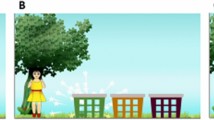Abstract
We describe the design of a Web-based game application aimed to support high-functioning individuals affected by Autism Spectrum Disorder in gaining skills that can help them understand the concept of money and apply it in practical life situations. In order to evaluate the effectiveness and usability of the games, a user study involving six high-functioning ASD individuals in their teens and above was carried out. Preliminary results were encouraging and showed the potential advantages of such a system for training end users on practical life skills. We report on the redesign of the application that has been performed taking into account also the feedback gathered in the empirical validation. During the redesign we also added a more realistic game involving interaction with a vending machine, a tool that is commonly used by teenagers to buy snacks or drinks.









Similar content being viewed by others
References
American Psychiatric Association (2013) Diagnostic and statistical manual of mental disorders, 5th edn. American Psychiatric Association, Washington, D.C.
National Institute of Neurological Disorders and Stroke. Autism spectrum disorder fact sheet. Available at: https://www.ninds.nih.gov/Disorders/Patient-Caregiver-Education/Fact-Sheets/Autism-Spectrum-Disorder-Fact-Sheet.
Aresti-Bartolome N, Garcia-Zapirain B (2014) Technologies as support tools for persons with autistic Spectrum disorder: a systematic review. Int J Environ Res Public Health 11(8):7767–7802. https://doi.org/10.3390/ijerph110807767
Bossavit B, Parsons S (2016) Designing an educational game for and with teenagers with high functioning autism. In: Bossen C, Smith RC, Kanstrup AM, McDonnell J, Teli M, Bødker K (eds) Proceedings of the 14th participatory design conference: full papers - volume 1 (PDC '16), vol 1. ACM, New York, pp 11–20. https://doi.org/10.1145/2940299.2940313
Moore D (1998) Computers and people with autism / Asperger syndrome, in communication (the magazine of the National Autistic Society), pp 20–21
Cafiero J (2005) Meaningful exchanges for people with autism: an introduction to augmentative & alternative communication. Woodbine House, Bethesda
Delano ME (2016) Video modeling interventions for individuals with autism. Remedial Spec Educ 28(1):33–42
Bernardini S, Porayska-Pomsta K, Smith TJ (2014) ECHOES: an intelligent serious game for fostering social communication in children with autism. J Inf Sci 264:41–60
Odom SL, Thompson JL, Hedges S, Boyd BA, Dykstra JR, Duda MA, Szidon KL, Smith LE, Bord A (2015) Technology-aided interventions and instruction for adolescents with autism spectrum disorder. J Autism Dev Disord 45:3805–3819. https://doi.org/10.1007/s10803-014-2320-6
Hong APCI, van Heugten S, Kooken T, Vinke N, Vromans M, Shahid S The augenda: structuring the lives of autistic teenagers. In: Proceedings of the 12th international ACM SIGACCESS conference on computers and accessibility (ASSETS '10). ACM, New York, pp 283–284. https://doi.org/10.1145/1878803.1878872
Shattuck PT, Wagner M, Narendorf S, Sterzing P, Hensley M (2011) Post-high school service use among young adults with an autism spectrum. Arch Pediatr Adolesc Med 165(2):141–146
Waters HE, Boon RT (2011) Teaching money computation skills to high school students with mild intellectual disabilities via the TouchMath© program: a multi-sensory approach. ETADD 46(4):544–555
Schaefer Whitby PJ (2013) Teaching mathematics to students with high functioning autism. A GUIDE to teaching students with autism spectrum disorders
Morris RR, Kirschbaum CR, Picard RW Broadening accessibility through special interests: a new approach for software customization. In: Proceed. ASSETS '10. ACM, pp 171–178. https://doi.org/10.1145/1878803.1878834
Ploog BO, Scharf A, Nelson D, Brooks PJ (2013) Use of computer-assisted technologies (CAT) to enhance social, communicative, and language development in children with autism spectrum disorders. J Autism Dev Disord 43:301–322. https://doi.org/10.1007/s10803-012-1571-3
Kapp SK, Gantman A, Laugeson EA (2011) Transition to adulthood for high-functioning individuals with autism spectrum disorders. University of California, Los Angeles
Donaldson JB, Zager D (2010) Mathematics interventions for students with high functioning autism/Asperger's syndrome. Teach Except Child 42(6):40–46
Sharma S, Srivastava S, Achary K, Varkey B, Heimonen T, Hakulinen J, Turunen M, Rajput N (2016) Gesture-based interaction for individuals with developmental disabilities in India. In: Proceedings of the 18th international ACM SIGACCESS conference on computers and accessibility (ASSETS '16). ACM, New York, pp 61–70. https://doi.org/10.1145/2982142.2982166
Mei C, Mason L, Quarles J (2014) Usability issues with 3D user interfaces for adolescents with high functioning autism. In: Proceedings of the 16th international ACM SIGACCESS conference on Computers & accessibility (ASSETS '14). ACM, New York, pp 99–106. https://doi.org/10.1145/2661334.2661379
Kamaruzaman MF, Rani NM, Md Nor H, Haji Azahari MH (2016) Developing user interface design application for children with autism. Procedia Soc Behav Sci 217:887–894
Pavlov N (2014) User Interface for people with autism spectrum disorders. J Softw Eng Appl 7(2):Article ID:43152,7 pages. https://doi.org/10.4236/jsea.2014.72014
Pagani Britto TC, Pizzolato EB (2016) Towards web accessibility guidelines of interaction and interface design for people with autism spectrum disorder. Proceedings of the ninth international conference on advances in computer-human interactions
Malagoli M (2001) Laboratorio euro, Edizioni Centro Studi Erickson S.p.A, Trento
Brooke J (1996) SUS: a "quick and dirty" usability scale. In: Jordan PW, Thomas B, Weerdmeester BA, McClelland AL (eds) Usability evaluation in industry. Taylor and Francis, London
Grandgeorge M, Masataka N (2016) Atypical color preference in children with autism spectrum disorder. Front Psychol 7:1976. https://doi.org/10.3389/fpsyg.2016.01976
Author information
Authors and Affiliations
Corresponding author
Rights and permissions
About this article
Cite this article
Caria, S., Paternò, F., Santoro, C. et al. The Design of Web Games for Helping Young High-Functioning Autistics in Learning How to Manage Money. Mobile Netw Appl 23, 1735–1748 (2018). https://doi.org/10.1007/s11036-018-1069-0
Published:
Issue Date:
DOI: https://doi.org/10.1007/s11036-018-1069-0




